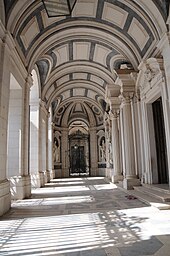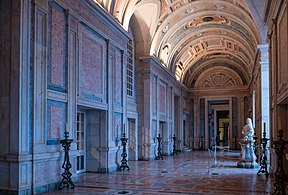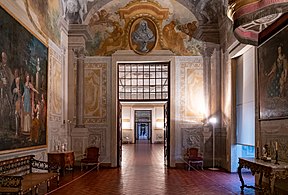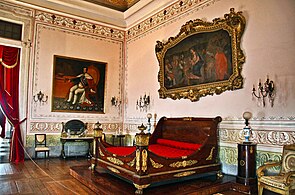Palace of Mafra
This article needs additional citations for verification. (March 2014) |
| National Palace of Mafra | |
|---|---|
Palácio Nacional de Mafra | |
 Main façade of the palace | |
 | |
| General information | |
| Location | Mafra, Portugal |
| Coordinates | 38°56′13″N 9°19′33″W / 38.9369°N 9.3258°W |
| Official name | Royal Building of Mafra – Palace, Basilica, Convent, Cerco Garden and Hunting Park (Tapada) |
| Criteria | Cultural: (iv) |
| Reference | 1573 |
| Inscription | 2019 (43rd Session) |
| Area | 1,213.17 ha (2,997.8 acres) |
| Buffer zone | 693.239 ha (1,713.03 acres) |
Portuguese National Monument | |
| Type | Non-movable |
| Criteria | National Monument |
| Designated | 10 January 1907 |
| Reference no. | IPA.00006381 |
The Palace of Mafra (Portuguese: Palácio de Mafra), also known as the Palace-Convent of Mafra and the Royal Building of Mafra (Real Edifício de Mafra), is a monumental Baroque and Neoclassical palace-monastery located in Mafra, Portugal, some 28 kilometres from Lisbon. Construction began in 1717 under King John V of Portugal and was completely concluded in 1755.
The palace was classified as a
History

The
The construction was funded in large part from the proceeds of the colonies in Brazil, where gold and then diamonds were mined in vast quantities.[3]
This vast complex, largely built of
Construction
The exact site was chosen in 1713 and purchased in 1716. Construction began by the laying of the first stone on November 17, 1717, with a grand ceremony in the presence of the king, his entire court and the Cardinal Patriarch of Lisbon.

Initially it was a relatively small project for a friary of 13

He appointed an architect João Frederico Ludovice as director of the royal works at Mafra. Ludwig had studied architecture in Rome and knew contemporary Italian art. The extent of Ludwig's responsibility is unclear, as several other architects were involved in this project: the Milanese builder Carlos Baptista Garbo, Custódio Vieira, Manuel da Maia and even his own son António. However the application of the same architectural style over the whole building suggests the work of Ludwig as the head-architect in charge of the Royal Office of Works (Real Obra).
Construction lasted 13 years and mobilized a vast army of workers from the entire country (a daily average of 15,000 but at the end climbing to 30,000 and a maximum of 45,000), under the command of António Ludovice, the son of the architect.[11] In addition 7,000 soldiers were assigned to preserve order at the construction site.[12] They used 400 kg of gunpowder to blast through the bedrock for the laying of foundations. There was even a hospital for the sick or wounded workers. A total of 1,383 workers died during the construction.[13]
The facade is 220 meters long. The whole complex covers 37,790 m2 with about 1,200 rooms, more than 4,700 doors and windows, and 156 stairways.[14][15]
When complete the building consisted of a friary capable of sheltering 330 friars, along with a royal palace and a huge library of 30,000 books, embellished with
The basilica and the convent were inaugurated on the day of the King's 41st birthday on October 22, 1730. The festivities lasted for 8 days and were of a scale never seen before in Portugal. The basilica was dedicated to Our Lady and to St. Anthony.
However the building was not finished. The lantern on the cupola was completed in 1735. Work continued until 1755, when the work force was needed in Lisbon by the devastations of the Lisbon earthquake.[16]
Later history


The palace was not occupied permanently by the royalty, who considered the rooms too gloomy. Nonetheless, it was a popular destination for the members of the royal family who enjoyed hunting in the nearby game preserve, the
In 1834, after the
The last king of Portugal,
Description

Façade
The imposing façade, built of local limestone, is 220 m long and faces the town of Mafra. At each end of the façade stands a square tower with a bulbous dome, such as found in Central Europe. The church, built in white marble, is located in the centre of the main façade, symmetrically flanked on both sides by the royal palace. The king, wishing to rival the splendour of Rome, had sought architectural advice from his ambassador to the Vatican, who sent him small-scale models of important Roman religious buildings. The benedictal balcony at its centre is clearly mirrored on the balcony of St. Peter's Basilica in Rome. But this balcony is rather intended for the king, as a symbol of his power, than for the benedictions by a prelate.
The two church towers (68 m high) are inspired by the towers of Sant'Agnese in Agone (by the Roman Baroque architect Francesco Borromini). Their two carillons contain a total of 92 church bells, founded in Antwerp. The story goes that the Flemish bell-founders were so astonished by the size of their commission, that they asked to be paid in advance. The king retorted by doubling the offered amount. These carillons constitute the largest historical collection in the world.
The two towers are connected by two rows of
Royal Palace
The spacious royal apartments are situated on the second floor. The apartments of the king are situated at the end of the palace while the apartment of the queen is 200 m away at the other end. Such was this distance that, when the king left his apartment towards the apartment of the queen, this was announced to the queen by the sound of a trumpet.
As king John VI had taken with him some of the best pieces of art and furniture in the building when the royal family fled in 1808 for the advancing French troops to Brazil, most rooms had to be redecorated in the original style. The Hunting trophy room (Sala dos Troféus) is decorated with numerous skulls of deer, the furniture is constructed of antlers and covered with deerskin and even the candleholders are made of deer antlers.
The Benediction Gallery (Sala da Benção) borders at the upper level of the basilica. The royal family could here attend Mass, seated at a window opening unto the basilica. The bust of John V in this hall is a work of the Italian Alessandro Giusti. The Throne Room, the Guard Room and the Room of Goddess Diana are decorated with murals by artist such as Ciryllo Wolkmar Machado, Bernardo Oliveira Góis and Vieira Lusitano.
Basilica



The church is built in the form of a Latin cross with a length of 63 m. It is rather narrow (16.5 m), an impression accentuated by the height of its nave (21.5 m). The vestibule (Galilee porch) contains a group of large sculptures in Carrara marble, representing the patron saints of several monastic orders.
The interior makes abundantly use of local rose-coloured marble, intermingled with white marble in different patterns. The multi-coloured designs of the floor are repeated on the ceiling. The barrel vault rests on fluted Corinthian semicolumns standing between the side chapels. The chapels in the transept contain altarpieces in jasper made by sculptors from the School of Mafra. The side aisles display 58 marble statues commissioned from the best Roman sculptors of their time. The All Saint's chapel in the transept is screened from the crossing by iron railings with bronze ornaments, made in Antwerp.
The choir has a magnificent giant candleholder with seven lamps sprouting from the mouth of seven rolled-up snakes. Above the main altar, inserting into the ceiling, is a gigantic jasper crucifix of 4.2 m, flanked by two kneeling angels, made by the School of Mafra. The cupola over the crossing was also inspired by the cupola of Sant'Agnese in Agone (by the Roman Baroque architect Francesco Borromini). This 70 m-high cupola with a small lantern atop, is carried by four finely sculpted arcs in rose and white marble.

There are six organs, four of which are located in the transept, constituting a rather uncommon ensemble. There were built by Joaquim Peres Fontanes and António Xavier Machado Cerveira between 1792 and 1807 (when the French troops occupied Mafra). They were made out of partially gilded Brazilian wood. The largest pipe is 6 m high and has a diameter of 0.28 m. King John V had commissioned liturgical vestments from master embroiderers from Genoa and Milan, such as Giuliano Saturni and Benedetto Salandri, and from France. They attest of superb quality and workmanship by their embroidering in gold technique and the use of silk thread in the same colour.
The religious paintings in the basilica and the convent constitute one of the most significant 18th century collections in Portugal. They include works by the Italians Agostino Masucci, Corrado Giaquinto, Francesco Trevisani, Pompeo Batoni and some Portuguese students in Rome such as Vieira Lusitano and Inácio de Oliveira Bernardes. The sculpture collection contains works by almost every major Roman sculptor from the first half of the 18th century. At that time, it represented the biggest single order done by a foreign power in Rome and still is one of the biggest collections in existence.
The parish of Mafra (Santo André de Mafra) and the Royal and Venerable Confraternity of the Most Blessed Sacrament of Mafra (Portuguese: Real e Venerável Irmandade do Santíssimo Sacramento de Mafra) have their headquarters in the basilica.
On 10 November 2020, Pope Francis granted a canonical coronation to the image of Our Lady of Solitude of the basilica, guarded by the Confraternity of the Most Blessed Sacrament.[19]
Library


The
The library is known for homing bats which protect the books from insect damage.[20] The library's bat colony includes grey long-eared bats and serotine bats.[21]
The library was used in
Convent

The rectangle behind the church and the palace houses the
Mafra School of Sculpture

The Mafra School of Sculpture was founded during the reign of king Joseph I of Portugal, successor of king John V. As the Mafra National Palace had a great need for sculptors, local and from abroad, it became the location of a sculpture academy headed by the Italian Alessandro Giusti (1715–1799).
Among the teachers were several important sculptors, such as José de Almeida (1709–1769), Claude de Laprade (1682–1738) and Giovanni Antonio da Padova (who created most of the statues for the cathedral of Évora).
The academy was awarded many commissions by the Augustinians from the monastery, resulting in the many marble statues and retables in marble and jasper in the basilica. This academy produced several generations of Portuguese sculptors, such as Joaquim Machado de Castro (1731–1822).
Cultural influence
A major reference to the construction of the palace is made in the novel
See also
- Other Portuguese royal residences:
- Sintra National Palace
- Ajuda National Palace
- Belém Palace
- Palace of Necessidades
- Pena National Palace
- Queluz National Palace
- List of Baroque residences
- Royal and Venerable Confraternity of the Most Blessed Sacrament of Mafra
- List of carillons
References
- "Palácio e Convento de Mafra" (in Portuguese). Direção Geral do Património Cultural.
- Turner, J. – ISBN 0-19-517068-7
- Rentes de Carvalho J. – Portugal, um guia para amigos (in Dutch translation : Portugal); De Arbeiderspers, Amsterdam; 9th ed. August 1999; ISBN 90-295-3466-4
- The Rough Guide to Portugal – 11th ed. March 2005; ISBN 1-84353-438-X
- The National Palace of Mafra, an English guide; IPPAR, July 2005 (on sale in the palace)
Notes
- ^ "Six cultural sites added to UNESCO's World Heritage List". UNESCO. 7 July 2019.
- ^ Born "Maria Anna" of Austria but known as "Mariana" in Portugal
- ISBN 978-0-330-49073-3
- ^ "Palácio Nacional de Mafra". Câmara Municipal de Mafra. 2015-06-18. Archived from the original on 2018-04-09. Retrieved 2018-04-09.
- ^ "Palácio Nacional de Mafra - Biblioteca". www.palaciomafra.gov.pt (in Portuguese). Retrieved 2018-04-09.
- ^ "Palácio Nacional de Mafra - Basílica". www.palaciomafra.gov.pt (in Portuguese). Retrieved 2018-04-09.
- ^ "Palácio Nacional de Mafra - Órgãos". www.palaciomafra.gov.pt (in Portuguese). Retrieved 2018-04-09.
- ^ "Palácio Nacional de Mafra, History". Câmara Municipal de Mafra. 2015-06-18. Archived from the original on 2019-03-22. Retrieved 2018-04-09.
- ^ "Palácio Nacional de Mafra - Carrilhões". www.palaciomafra.gov.pt (in Portuguese). Retrieved 2018-04-09.
- ^ The construction of the palace was so costly that it consumed virtually all of the Brazilian gold, which might otherwise have been used to benefit the general economy of Portugal. Toby Green, Inquisition: The Reign of Fear, p. 315.
- ^ "Ludovice, Arquitecto ou Capataz". Monumento de Mafra Virtual (in Portuguese). Archived from the original on March 7, 2021. Retrieved August 28, 2022.
- ^ "Palácio Nacional de Mafra". Monumentos. Retrieved 2018-04-13.
- ^ "Guiao de Vista de Estudo: Palaciio-Convento de Mafra" (PDF) (in Portuguese). Colegio de Sao Tomas. 2018. Archived from the original (PDF) on March 22, 2020. Retrieved August 28, 2022.
- ^ "National Palace of Mafra". www.patrimoniocultural.gov.pt (in Portuguese). Retrieved 2018-04-09.
- ^ "Palácio Nacional de Mafra - Real Obra de Mafra". www.palaciomafra.gov.pt (in Portuguese). Retrieved 2018-04-09.
- ^ "The Mafra National Palace in Numbers". A Portuguese Affair. April 27, 2017. Archived from the original on August 28, 2022. Retrieved August 28, 2022.
- ^ "Os seis órgãos de Mafra" (PDF) (in Portuguese). PN Mafra. Archived from the original (PDF) on November 12, 2014. Retrieved August 28, 2022.
- ^ "Restauro dos seis órgãos da Basílica de Mafra distinguido com galardão "Europa Nostra" | Secretariado Nacional da Pastoral da Cultura".
- ^ "Papa concede Coroação Pontifícia a imagem venerada na Basílica de Mafra". RTP (in Portuguese). Retrieved 2020-12-13.
- ^ Hartnett, Kevin (17 September 2013). "Bats eat bookworms". Boston Globe archive website. Brainiac blog hosted by Boston Globe. Retrieved 14 June 2018.
- ^ Case, Julie H. (7 June 2018). "These Portuguese Libraries Are Infested With Bats—and They Like It That Way". Smithsonian Magazine.
- ^ "Gulliver's Travels (1996– ) Filming & Production". IMDb. Retrieved 2018-04-13.
- ^ "Congresso Internacional sobre 'Memorial do Convento'".
External links
![]() Media related to Palácio Nacional de Mafra at Wikimedia Commons
Media related to Palácio Nacional de Mafra at Wikimedia Commons
- Palácio Nacional de Mafra (in Portuguese)





